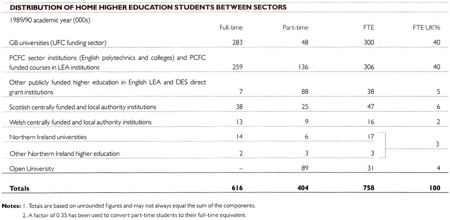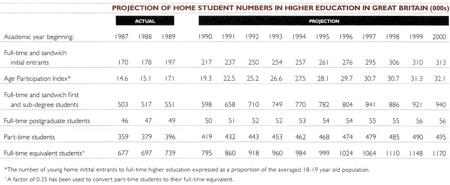[page 37]
CHAPTER 8
CONCLUSION AND SUMMARY
105 The Government has concluded that the future development of higher education will be enhanced by the elimination of the binary line. In particular, increased competition among the present universities, polytechnics and colleges will promote the further efficient expansion which the Government wants to see.
106 Taken together with the Government's policies in schools and further education, it can be expected that nearly one in three of all young people will enter higher education by the year 2000, and that participation by mature entrants will also increase. The Government is determined to maintain and enhance the quality of higher education, and to ensure that this education is increasingly relevant to students' various needs. This will benefit both the individuals who participate and the economy and society as a whole.
107 Higher education in the United Kingdom is already amongst the most efficient and effective in the world. The Government applauds what the academic community has achieved in teaching, scholarship and research. It expects the new framework proposed in this White Paper and summarised below to provide for yet greater achievements in the future.
SUMMARY
108 The main features of the Government's plans for bringing universities, polytechnics and major colleges of higher education into a Single structure for higher education are:
- the establishment of Higher Education Funding Councils within England, Scotland and Wales to distribute public funding to institutions in their areas to support both teaching and non-specific
[page 38]
research; and new links to continue the close relationship between Northern Ireland's existing unitary structure and provision elsewhere in the United Kingdom;
- the extension of degree awarding powers to polytechnics and some other institutions; and the consequent winding up of the Council for National Academic Awards;
- the introduction of new measures concerning quality assurance, principally:
- external scrutiny of institutional quality control arrangements across the United Kingdom by a quality audit unit developed essentially by the institutions themselves;
- units within each Higher Education Funding Council to assess and advise on quality across the funded institutions; and
- co-operation among the Funding Councils to maintain a common approach; and
- permitting polytechnics and, subject to the development of suitable criteria, other major institutions to adopt the title of university
109 This White Paper also sets out the Government's intentions to consult on various matters relating to the new framework and the provision to be made within it, namely:
- measures to promote developments which will assist in achieving the required expansion with greater efficiency;
- arrangements for supporting computing in higher education, currently undertaken by the UFC's Information Systems Committee;
- the criteria and arrangements for extending degree awarding powers beyond the present polytechnics;
- the nature and development of the proposed quality audit unit;
- the scope for extending the use of the title of university beyond present polytechnics;
- the financial year to be adopted across higher education; and
- arrangements for bringing greater coherence to statistical information across higher education.
[page 39]
ANNEX I
THE PRESENT FRAMEWORK
1 The main features of the current organisation of higher education in the United Kingdom are as follows:
- The universities in England, Scotland and Wales are, except for the directly funded Open University and the independent University of Buckingham, funded for both teaching and research through the Universities Funding Council (UFC) established under the Education Reform Act 1988. Lead responsibility within Government is taken by the Secretary of State for Education and Science.
- There are separate arrangements for the funding of teaching in non-university higher education:
- within England, the 1988 Act re-established polytechnics and other major local education authority (LEA) colleges of higher education as independent free-standing institutions, and set up the Polytechnics and Colleges Funding Council (PCFC) as the channel of public funding to a new sector composed of those institutions and all but a few of those formerly directly funded by the Secretary of State for Education and Science. The PCFC also funds most of the higher education provided alongside further education in LEA colleges;
- within Scotland, the Central Institutions and Colleges of Education are directly funded by the Secretary of State for Scotland. Some higher education is also provided in local authority further education colleges; and
- within Wales, the Polytechnic and some colleges are currently maintained by local authorities, while one college is directly funded by the Secretary of State for Wales. Local authority funding is determined at a national level by the Secretary of State with advice from the Wales Advisory Body for Local Authority Higher Education. The local authority higher education institutions in Wales are to become independent free-standing institutions from April 1992
- Northern Ireland's higher education is already largely constituted as a unitary system. Central funding of the universities by the Secretary of State for Northern Ireland takes account of advice from the UFC, with the aim of ensuring broad parity of provision with universities elsewhere in the United Kingdom.
[page 40]
2 Public funding for specific research projects throughout the United Kingdom is managed by the Research Councils.
3 Alongside institutional funding, higher education institutions also receive public funds in the form of tuition fees paid on behalf of students in receipt of an award. To encourage more efficient expansion in higher education, the Government has substantially shifted the balance of public funding from institutional grant to tuition fees. The standard undergraduate tuition fee has been increased from £607 in the academic year 1989/90 to £1675 in 1990/91 In the academic year 1991/92, the fee will be differentiated into three bands to reflect the relative costs of classroom, laboratory/workshop and clinical courses. The average fee (of some £2,200) will amount to nearly half the teaching cost per student made available from public funds. This compares to about 15 per cent in 1989/90. In the case of Oxford and Cambridge Universities, public funding in the form of institutional funding from the UFC and tuition fees for award holding students flows only to the parent universities. The colleges receive public funds in the form of college fees which, like tuition fees, are paid on behalf of award holding students. These arrangements were considered in the Croham Committee's 1987 report on university funding matters (Review of the University Grants Committee, Cm 81).
4 In the 1989/90 academic year, the distribution of students within United Kingdom higher education was as follows:
 [click on the image for a larger version]
[click on the image for a larger version]
[page 41]
ANNEX 2
PROJECTION OF STUDENT NUMBERS
1 The chart in Chapter 1 shows the Department of Education and Science's April 1991 projection to the year 2000 of:
- numbers of full-time equivalent home students in higher education in Great Britain; and
- the associated Age Participation Index for young home initial entrants to full-time and sandwich first and sub-degree courses.
Like its predecessors, the April 1991 projection is derived from the methodology set out in Projections of Demand for Higher Education in Great Britain 1986-2000 (Department of Education and Science 1986). The results are shown in the following table.
 [click on the image for a larger version]
[click on the image for a larger version]
[page 42]
ACKNOWLEDGEMENT
The co-operation of universIties, polytechnics and colleges in the provision of photographs for use in this White Paper is gratefully acknowledged,






